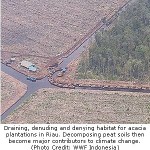
Bonn – Europe’s rarest songbird, the Aquatic Warbler, will be better protected following decisions taken at a key meeting of the UN Environment Programme’s Convention on the Conservation of Migratory Species of Wild Animals (CMS).
The meeting in Biebrza National Park (Poland) agreed to extend the geographical coverage of the CMS Agreement on the Aquatic Warbler (which originally comprised 15 countries) to include seven new countries in Europe and Africa along the migration route of the Aquatic Warbler and in its wintering areas in sub-Sahelian Africa: Luxembourg, Mali, Mauritania, Morocco, Portugal, Slovakia and Switzerland.
The meeting also adopted a new International Species Action Plan for the Aquatic Warbler, prepared by CMS’s partner BirdLife International on behalf of the European Union. It will help to protect the Aquatic Warbler throughout its range and help its breeding populations expand to sites that had been lost in the past.
In addition to giving a detailed account of the distribution, biology and conservation status of the bird species, the plan envisages concrete actions to be taken by the countries. Governments are committed to adopt wildlife laws to safeguard the bird species, its breeding sites and winter quarters along its migration route. Research and monitoring will help track population trends and identify new wintering areas. The discovery of the only wintering site in Senegal in 2007 is a milestone towards long term conservation efforts under CMS.
CMS Executive Secretary Elizabeth Maruma Mrema said, “We must redouble our efforts to protect this unique songbird. New concerted actions in Europe and Africa to save this most endangered bird species during the International Year of Biodiversity will also maintain the crucial wetlands on which so many other species depend.”
At the meeting, the Polish partner of BirdLife International, the Polish Society for the Protection of Birds (OTOP) shared data with the scientific community on new technologies to restore the Aquatic Warbler’s sensitive peatland habitat. As part of a 5 million project largely funded by the European Union’s LIFE Nature programme, conservation work started in nine project sites in Poland and Germany in 2005, covering 42,000 hectares.
As a result, fauna and flora in the fen mires that are key to the natural balance of watersheds have now regained their former diversity in the Biebrza Valley. Fen mires act as carbon store, thus easing the greenhouse effect. Drained mires release greenhouse gases as a result, the emissions in Belarus from drained mires are higher than those from all road traffic in the country. Where trees and bushes were previously slowly overgrowing the valuable peat meadows, lapwings, redshanks, black-tailed godwits, great snipes and the return of the Aquatic Warbler can now be observed.
The Aquatic Warbler is the rarest and the only globally threatened passerine bird found in mainland Europe. Apart from a very small remnant population in West Siberia, its breeding grounds are completely confined to Europe. Once widespread and numerous in fen mires and wet meadows throughout the continent, the Aquatic Warbler has disappeared from most of its former range. Nowadays, its global population of only 10,200-13,800 males is confined to less than 40 sites in only six countries, with four sites supporting over 80 per cent of the global population. The only regular wintering site known so far is the one discovered in Senegal. Habitat loss in Sub-Sahelian Africa is likely to turn into a bottleneck.
The Aquatic Warbler inhabits large open sedge and fen mires, which have suffered a very severe decline in western and central Europe due to habitat loss caused largely by agricultural activities and peat extraction. In addition, changes in the water management such as channelizing and deepening of river beds have had a severe impact. Agricultural abandonment and uncontrolled burning and draining of wetlands have led to serious consequences. In the wintering grounds, habitat loss as a result of population increase, fresh water reservoirs, hydro-agriculture, desertification and overgrazing are most severe.
France, one of the main range states to the Aquatic Warbler, and Mali signed the CMS agreement on Aquatic Warblers during the conference, bringing the total number of signatories to 14 (out of 15 range states).
France is especially important, because the entire world population of Aquatic Warblers passes through France once or twice a year, when the birds depend on intact refueling stations. Mali is also considered a potentially critically important country for the Aquatic Warbler. Scientists believe that a very important part of the world population could wait out the winter season in the country as an international expedition aimed at identifying the bird’s wintering sites is planned for next year.
Following World Migratory Bird Day 2010, celebrated around the world on 8-9 May, this expert meeting is the first one to adopt the theme, ‘Save migratory birds in crisis – every species counts!’
Notes:
The Convention on the Conservation of Migratory Species of Wild Animals (Bonn Convention) is an intergovernmental treaty concluded under the United Nations Environment Programme and focusing on the conservation of migratory species and their habitats. CMS concluded the Memorandum of Understanding concerning Conservation Measures for the Aquatic Warbler. This CMS agreement provides the basis for governments, NGOs and scientists to work together to save the Aquatic Warbler and its habitats.
At the global level, the Aquatic Warbler is classified as “Vulnerable” by the International Union for Conservation of Nature’s (IUCN) Red List. It is included in CMS Appendix I and designated for concerted action under the Convention, Annex I of the EC Wild Birds Directive, in Appendix II of the Bern Convention.














